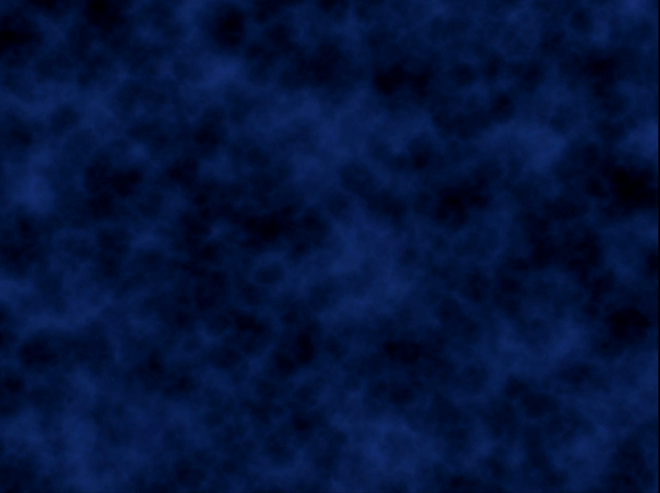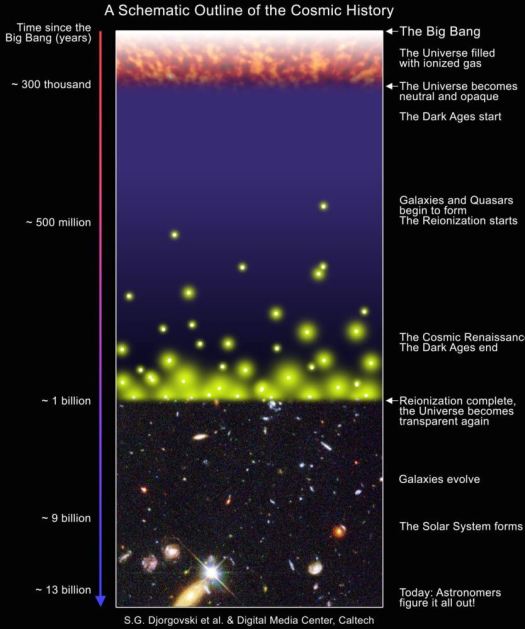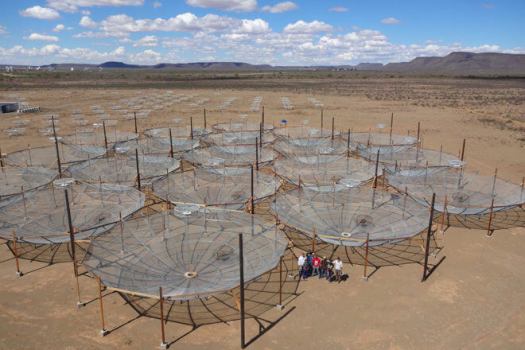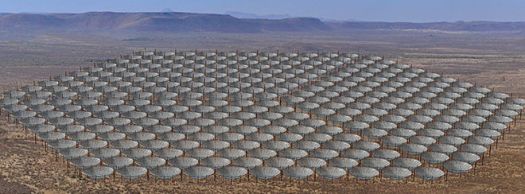
Before there were planets in our solar system, there was a star that would become our sun. Before there was a sun, there were older stars and exoplanets throughout the galaxies.
Before there were galaxies with stars and exoplanets, there were galaxies with stars and no planets. Before there were galaxies without planets, there were massive singular stars.
And before that, there was darkness for more than 100 million years after the Big Bang — a cosmos without much, or at times any, light.
So how did the lights get turned on, setting the stage for all that followed? Scientists have many theories but so far only limited data.
In the coming years, that is likely to change substantially.
First, the James Webb Space Telescope, scheduled to launch in 2018, will be able to look back at distant galaxies and stars that existed in small or limited numbers during the so called Dark Ages. They gradually became more prevalent and then suddenly (in astronomical terms) became common. Called the epoch of cosmic “reionization,” this period is an essential turning point in the evolution of the cosmos.
Less well known but also about to begin pioneering work into how and when the lights came on will be an international consortium led by a team at the University of California, Berkeley. Unlike the space-based JWST, this effort will use an array of radio telescopes under construction in the South African desert. The currently small array will expand quickly now thanks in large part to a $9.6 million grant recently announced from the National Science Foundation.
Named the Hydrogen Epoch of Reionization Array (HERA), the project will focus especially on the billion-year process that changed the fundamental particle physics of the universe to allow stars, galaxies and their light burst out like spring flowers after a long winter. But unlike the JWST, which will be able to observe faint and very early individual galaxies and stars, HERA will be exploring the early universe as a near whole.

Aaron Parsons, an associate professor at Berkeley and principal investigator of the HERA project, said his team is now ready to grow their proof-of-concept array to a full-fledged observatory with 270 radio telescopes, with science that just might give some solid answers about how the lights came on.
Parsons said they see their effort as a continuation of the earlier pioneering work that identified and mapped the cosmic microwave background radiatio that was produced by another cosmos-changing event some 380,000 years after the Big Bang.
“We have learned a ton about the cosmology of our universe from studies of the cosmic microwave background, but those experiments are observing just the thin shell of light that was emitted from a bunch of protons and electrons that finally combined into neutral hydrogen 380,000 years after the Big Bang,” Parsons said.
“We know from these experiments that the universe started out neutral {at that point}, and we know that it ended ionized, and we are trying to map out how it transitioned between those two.”

More specifically, here is what cosmologists and astrophysicists theorize or know happened:
The Big Bang produced a scorching cauldron of particles that had electrical charge. That condition ended with the ‘recombination” event that joined protons and neutrons together to form atomic hydrogen, and as a result produced the cosmic microwave background radiation.
What followed was 100 million or more years of abject darkness because the atomic hydrogen was neutral and unable to do much of anything. Some relatively few stars appeared in those Dark Ages, when enough gas clumped together and set off a star-forming gravitational collapse.
Those stars, and later dwarf galaxies, emitted photons which had the effect of splitting (or ionizing) the hydrogen that surrounded them — creating bubbles of charged hydrogen (and some helium) in a vast ocean of neutral hydrogen.
Much remains unknown about how and when the population of stars and galaxies grew over the ensuing hundreds of millions of years during this epoch of reionization. But a time came, an estimated one billion years after the Big Bang, when the islands of split hydrogen turned into a universe of split hydrogen. That made widescale star and galaxy formation possible.
Many astronomers study primordial stars and galaxies to learn about this still mysterious process, but the HERA project will analyze instead how those earliest celestial objects changed the nature of intergalactic space. And that essentially means capturing tiny changes in the vast universe of uncharged hydrogen during and after the Dark Ages, since hydrogen was most of what was present.
As Parsons explained it, the changes within hydrogen atoms they are looking for were weak and occurred only infrequently — perhaps once in 10 million years for a single atom of hydrogen. “But there’s an awful lot of hydrogen out there, and that allows the weakness to be an advantage. That means we can see through clouds, can see deep into the hydrogen clouds,” and that allows for observing on a much longer time scale.
The goal of the HERA project is, most broadly, to trace those minute changes in hydrogen from about 100 million years after the Big Bang to one billion years after, when the epoch of reionization culminated with a conclusive turning on of the universe.

The HERA array currently has 19 radio telescopes, will grow to 37 soon, and to 270 in 2018. The team hopes to some day expand to 350 telescopes. Each is a of radio dish looking fixedly upwards and measuring primordial radiation. It was originally emitted at a wavelength of 21 centimeters, a key spectral tracer for the neutral hydrogen atom. The photons have been been stretched by a factor of 10 or more since it was emitted some 13 billion years ago, making the detections more easily measured.
The signal is nonetheless weak and has been difficult to measure. Previous experiments, such as the UC Berkeley-led Precision Array Probing the Epoch of Reionization (PAPER) in South Africa and the Murchison Widefield Array (MWA) in Australia, have not been sufficiently powerful and sensitive. But HERA is much more powerful and hopes are high.
The researchers will be looking for the boundaries between those bubbles of ionized hydrogen around early stars — which are invisible to HERA — and the surrounding neutral or atomic hydrogen being measured. By tuning the receiver to different wavelengths, they can map the bubble boundaries at different distances to follow the the evolution of the bubbles over time.
HERA is being constructed at the Karoo desert site where PAPER was deployed. Joining the Berkeley team will be scientists from England, South Africa, Italy, MIT, the National Radio Astronomical Observatory, the University of Washington, Arizona State University and others.
HERA was recently granted the status of a precursor telescope for the Square Kilometer Array (SKA), an ambitious project to build a vast collection of radio dishes around Africa and Australia — thereby creating the largest astronomical observatory of all time. HERA is located close by one of the South African SKA sites.
The HERA present:

The HERA future:

“Many Worlds” generally focuses on exoplanet science, so perhaps you’re wondering why you’re reading about the early universe, reionization and a radio telescope that will attempt to unravel its mysteries. One reason is simply that the subject is most intriguing, but also it speaks to two important aspects of exoplanet science.
The first is cosmic evolution, the many phenomena and processes that have led to a universe that features billions of planets and at least one (and most likely more) that hosts life.
The Dark Ages and epoch of reionization set the stage for a far more active universe, including supernova that explode and in the process produce otherwise absent carbon, oxygen, phosophrus and many of the elements needed for planets and for life are formed. Clearly, knowing more about how the stars, galaxies and interstellar medium evolved allows for deeper understandings of the history and characteristics of exoplanets.
But there is a technical connection between HERA and exoplanets as well. The array may well be quite useful in detecting certain important types of exoplanets — those with magnetic fields.
Parsons explained that when a host star emits a strong coronal mass ejection, the flare often comes into contact with orbiting exoplanets. Scientists know from studying Jupiter, which has an ionosphere and thus a magnetic field, that when the CME hits that field a radio pulse or burst is registered.
“In principle this could happen with lots of planets,” Parsons said. “A host star is active, sends out a big flare, it interacts with the magnetic field around a planet, and we could measure it.
“Potentially, we could detect planets this way, but more unique is that we can identify planets with magnetic fields. It’s not clear what role magnetic fields have in making life possible, but the Earth does have a strong magnetic field that protects us. That’s probably not an accident, and so it would be very valuable to identify planets with magnetic fields.”
So it’s possible that the effort to understand the epoch of reionization just might help uncover a trove of habitable planets.
